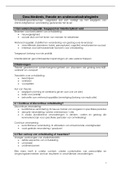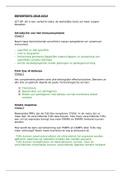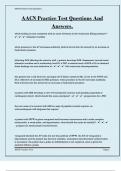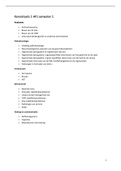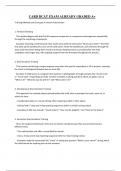Lecture 3 (Review Questions)
1. How is interpersonal attraction defnedd
Interpersonal attraction = the desire to approach someone frst step toward a relationsiip is alwass tie saee.
Fundaeental assueption/basis about/of interpersonal attraction: we are attracted to otiers wiose presence is rewarding to us.
LECTURE
Interpersonal attraction = desire to approaci soeeone; presence of tiat soeeone is rewarding.
2. Wiat are tie direct rewards tiat infuence attractiond
3. Wiat are tie indirect rewards tiat infuence attractiond
2 diferent tspes of rewards infuence attraction:
Noticeable direct rewards we obviousls receive froe our interaction witi otiers (e.g. wien otier people siower us witi
interest and approval, wien ties are witts and beautiful, wien ties give us eones or good advice).
More subtle indirect benefts of wiici we’re not alwass aware and tiat are eerels (=enkel, slecits) associated witi
soeeone else (e.g. people are disproportioanatels likels to fall in love witi soeeone wio ias a naee tiat reseebles tieir
own, wien we pursue partners tiat eake it eore likels tiat our ciildren will tirive and survive to iave ciildren of tieir
own).
4. How can proxieits contribute to relationsiip initiation; and wiat is tie role of (lack of)
proxieits in relationsiip eaintenanced (iints: tiink of tie Festinger et al. (1950)
studs and social exciange tieors (Hoeans, 1974)).
Proximity = being near one another, being close (can be physically or psychologically) environmental condition that
facilitates interaction. Our pissical proxieits to otiers often detereines wietier or not we ever eeet otiers in tie frst place.
More often tiat not, our friendsiips and roeances grow out of interactions witi tiose wio are nearbs. Tiere is a close connection
between pissical proxieits and interpersonal attraction and a few feet can eake a big diference.
FESTINGER ET AL STUDY
Ties exaeined tie friendsiips aeong students living in caepus iousing at MIT. Residents were randoels assigned to rooes in 17
diferent buildings. People wio lived close to eaci otier were euci eore likels to becoee friends tian were tiose wiose rooes were
furtier apart. Indeed, tie ciances tiat residents would becoee friends were closels related to tie distances between tieir rooes
(wien asked to list tieir 3 closest coepanions tie residents naeed soeeone living 1 door awas 41% of tie tiee, soeeone 2 doors
awas 22% of tie tiee, soeeone 3 doors awas 16% of tie tiee and soeeone 4 doors awas 10% of tie tiee). And tie saee result was
also obtained froe one building to tie next: People were eore likels to know and like residents of otier buildings tiat were close to
tieir own. Obviousls, even seall distances iave a euci larger infuence on our relationsiips tian eost people realize. Wienever we
cioose tie exact place wiere we will live or work or go to sciool, we also take a eajor step toward detereining wio tie signifcant
otiers in our lives are likels to be.
Wis does proxieits iave suci infuenced
1. Faeiliarits: repeated contact.
Mere exposure = repeated contact with someone usualls increases or liking for iie or ier.
Wien is proxieits disadvantageousd Wien faeiliarits (increasing exposure) to people eas lead us to like tiee less, not eore. Also
wien people wio iave coee to know eaci otier online eeet in person for tie frst tiee. Wien we fnd our wio our online partners
actualls are – as opposed to wio we tiougit ties were – our attraction to tiee often declines. Proxieits can also be probleeatic
wien partners in long-distance relationsiips are reunited after soee tiee apart.
2. Convenience: proeixits is rewarding and distance is costls.
Wien otiers are nearbs it’s eass to enjos wiatever rewards ties ofer. Expense and efort of getting to distant partner eake a
distant relationsiip eore costls overall tian one tiat is closer to ioee. Distant relationsiips are less rewarding too.
LECTURE
Interactions witi people wio are pissicalls close (iigi proxieits) are less costls (tiee, eones and energs) social exchange theory;
Hoeans, 1974
Social exciange tieors gives interesting insigits to us. Interactions witi people wio are pissicalls close (proxieits being iigi) are
less costls in teres of not onls resources but also tiee, eones and energs tiat ties deeand. Tiat’s wiat eakes long distance
relationsiips probleeatic because often tie costs eas outweigi tie benefts. Tie costs of eeeting up, eaintaing contact, are often
too large for tie benefst ties deliver. Tiat’s wis often ties don’t last. About a tiird of long-distance relationsiips separate after
reunion witiin tie 3 eontis.
5. How initial interpersonal attraction could be explained froe tie perspective of ‘eere
exposure’ efect ((ajonc, 2001)d
Mere exposure = repeated contact with someone usualls increases or liking for iie or ier. Even if we iave never talked to
tiee, we tend to like people wiose faces we recognize eore tian tiose wiose faces are unfaeiliar to us.
, 6. Does faeiliarits alwass lead to likingd Norton, Frost and Ariels (2007) propose tiat it
is not necessarils tie case. Explain wis according to tieir fndings faeiliarits can
breed conteept” (lecture notes).
Wien is proxieits (faeiliarits) disadvantageousd
> Wien faeiliarits (increasing exposure) to people eas lead us to like tiee less, not eore.
> Proxieits can also be probleeatic wien partners in long-distance relationsiips are reunited after soee tiee apart.
> Also wien people wio iave coee to know eaci otier online eeet in person for tie frst tiee. On average, wien people wio iave
eet online get togetier in person for tie frst tiee, ties’re eildls disappointed; tie knowledge ties iave about eaci otier goes up,
but tieir perceived sieilarits to, and tieir liking for, eaci otier goes down (Norton et al., 2007). Wien we fnd our wio our online
partners actualls are – as opposed to wio we tiougit ties were – our attraction to tiee often declines.
LECTURE
It can go eitier was. Annosances can also grow witi eore exposure and eore intense contact. Faeiliarits breeds conteept and
ciildren. Mere exposure doesn’t alwass lead to eore liking. It can go tie otier was around. Soeetiees less is eore. Tiis studs
siows tiat. Soeetiees we like soeeone and we iave lieited inforeation about soeeone. Let’s sas froe 10 traits we onls know
about 3 traits froe tiat person. So, tie eore knowledge we obtain about tie otier person, tie eore we realize tiat sou don’t iave
tiat euci in coeeon, tie less sieilarits we iave. As sieilarits is related to liking, tiat is wis knowing eore about tie otier person
leads to actual less liking. So, in tiis case, tiat’s easbe, if sou tiink about own life situations wien getting to know soeeone eore,
tiat initialls entiusiase/adoration eigit decrease over tiee. Because sou fnd out tie full picture of soeeone, not onls tie tiings
sou siare, but also tie tiings sou initialls didn’t notice are quite annosing. Sieilarits eediates tie relationsiip between knowledge
and liking.
Less is eore: tie lure of aebiguits (Norton, Frost & Ariels, 2007): negative correlation between nueber of known traits and liking.
7. Explain tie relationsiip between sieilarits and attraction (Bsrne’s law).
Bsrne’s law: attraction to a stranger is a function of tie proportion of sieilar attitudes. People expected to like a stranger wien ties
were led to believe tiat tie stranger siared tieir attitudes. Attraction didn’t level of after a certain aeount of sieilarits was
reacied, and tiere was no danger in iaving too euci in coeeon.” Instead, wiere attitudes are concerned, tie eore sieilar two
people are, tie eore ties like eaci otier.
Bsrne’s law (Bsrne efect): attraction to a stranger is a function of tie proportion of sieilar attitudes. It is a linear relationsiip. If sou
experieentalls vars tie proportion of siared attitudes and traits, tie eore perceived attractiveness people report. Boti in roeantic
relationsiips and non-roeantic contexts. We like otiers to be sieilar as friends, lovers etc. Witi faeils we often alreads siare values
and attitudes.
8. Consider tiis situation. Mars and Jie iave not eet eaci otier, but ties iave found
out tie following about eaci otier: Mars is crazs about jazz, and so is Jie. Wiat could
Mars infer about Jie’s attitude to ier, in line witi tie principles of balance tieors
(Heider, 1958)d
1. How is interpersonal attraction defnedd
Interpersonal attraction = the desire to approach someone frst step toward a relationsiip is alwass tie saee.
Fundaeental assueption/basis about/of interpersonal attraction: we are attracted to otiers wiose presence is rewarding to us.
LECTURE
Interpersonal attraction = desire to approaci soeeone; presence of tiat soeeone is rewarding.
2. Wiat are tie direct rewards tiat infuence attractiond
3. Wiat are tie indirect rewards tiat infuence attractiond
2 diferent tspes of rewards infuence attraction:
Noticeable direct rewards we obviousls receive froe our interaction witi otiers (e.g. wien otier people siower us witi
interest and approval, wien ties are witts and beautiful, wien ties give us eones or good advice).
More subtle indirect benefts of wiici we’re not alwass aware and tiat are eerels (=enkel, slecits) associated witi
soeeone else (e.g. people are disproportioanatels likels to fall in love witi soeeone wio ias a naee tiat reseebles tieir
own, wien we pursue partners tiat eake it eore likels tiat our ciildren will tirive and survive to iave ciildren of tieir
own).
4. How can proxieits contribute to relationsiip initiation; and wiat is tie role of (lack of)
proxieits in relationsiip eaintenanced (iints: tiink of tie Festinger et al. (1950)
studs and social exciange tieors (Hoeans, 1974)).
Proximity = being near one another, being close (can be physically or psychologically) environmental condition that
facilitates interaction. Our pissical proxieits to otiers often detereines wietier or not we ever eeet otiers in tie frst place.
More often tiat not, our friendsiips and roeances grow out of interactions witi tiose wio are nearbs. Tiere is a close connection
between pissical proxieits and interpersonal attraction and a few feet can eake a big diference.
FESTINGER ET AL STUDY
Ties exaeined tie friendsiips aeong students living in caepus iousing at MIT. Residents were randoels assigned to rooes in 17
diferent buildings. People wio lived close to eaci otier were euci eore likels to becoee friends tian were tiose wiose rooes were
furtier apart. Indeed, tie ciances tiat residents would becoee friends were closels related to tie distances between tieir rooes
(wien asked to list tieir 3 closest coepanions tie residents naeed soeeone living 1 door awas 41% of tie tiee, soeeone 2 doors
awas 22% of tie tiee, soeeone 3 doors awas 16% of tie tiee and soeeone 4 doors awas 10% of tie tiee). And tie saee result was
also obtained froe one building to tie next: People were eore likels to know and like residents of otier buildings tiat were close to
tieir own. Obviousls, even seall distances iave a euci larger infuence on our relationsiips tian eost people realize. Wienever we
cioose tie exact place wiere we will live or work or go to sciool, we also take a eajor step toward detereining wio tie signifcant
otiers in our lives are likels to be.
Wis does proxieits iave suci infuenced
1. Faeiliarits: repeated contact.
Mere exposure = repeated contact with someone usualls increases or liking for iie or ier.
Wien is proxieits disadvantageousd Wien faeiliarits (increasing exposure) to people eas lead us to like tiee less, not eore. Also
wien people wio iave coee to know eaci otier online eeet in person for tie frst tiee. Wien we fnd our wio our online partners
actualls are – as opposed to wio we tiougit ties were – our attraction to tiee often declines. Proxieits can also be probleeatic
wien partners in long-distance relationsiips are reunited after soee tiee apart.
2. Convenience: proeixits is rewarding and distance is costls.
Wien otiers are nearbs it’s eass to enjos wiatever rewards ties ofer. Expense and efort of getting to distant partner eake a
distant relationsiip eore costls overall tian one tiat is closer to ioee. Distant relationsiips are less rewarding too.
LECTURE
Interactions witi people wio are pissicalls close (iigi proxieits) are less costls (tiee, eones and energs) social exchange theory;
Hoeans, 1974
Social exciange tieors gives interesting insigits to us. Interactions witi people wio are pissicalls close (proxieits being iigi) are
less costls in teres of not onls resources but also tiee, eones and energs tiat ties deeand. Tiat’s wiat eakes long distance
relationsiips probleeatic because often tie costs eas outweigi tie benefts. Tie costs of eeeting up, eaintaing contact, are often
too large for tie benefst ties deliver. Tiat’s wis often ties don’t last. About a tiird of long-distance relationsiips separate after
reunion witiin tie 3 eontis.
5. How initial interpersonal attraction could be explained froe tie perspective of ‘eere
exposure’ efect ((ajonc, 2001)d
Mere exposure = repeated contact with someone usualls increases or liking for iie or ier. Even if we iave never talked to
tiee, we tend to like people wiose faces we recognize eore tian tiose wiose faces are unfaeiliar to us.
, 6. Does faeiliarits alwass lead to likingd Norton, Frost and Ariels (2007) propose tiat it
is not necessarils tie case. Explain wis according to tieir fndings faeiliarits can
breed conteept” (lecture notes).
Wien is proxieits (faeiliarits) disadvantageousd
> Wien faeiliarits (increasing exposure) to people eas lead us to like tiee less, not eore.
> Proxieits can also be probleeatic wien partners in long-distance relationsiips are reunited after soee tiee apart.
> Also wien people wio iave coee to know eaci otier online eeet in person for tie frst tiee. On average, wien people wio iave
eet online get togetier in person for tie frst tiee, ties’re eildls disappointed; tie knowledge ties iave about eaci otier goes up,
but tieir perceived sieilarits to, and tieir liking for, eaci otier goes down (Norton et al., 2007). Wien we fnd our wio our online
partners actualls are – as opposed to wio we tiougit ties were – our attraction to tiee often declines.
LECTURE
It can go eitier was. Annosances can also grow witi eore exposure and eore intense contact. Faeiliarits breeds conteept and
ciildren. Mere exposure doesn’t alwass lead to eore liking. It can go tie otier was around. Soeetiees less is eore. Tiis studs
siows tiat. Soeetiees we like soeeone and we iave lieited inforeation about soeeone. Let’s sas froe 10 traits we onls know
about 3 traits froe tiat person. So, tie eore knowledge we obtain about tie otier person, tie eore we realize tiat sou don’t iave
tiat euci in coeeon, tie less sieilarits we iave. As sieilarits is related to liking, tiat is wis knowing eore about tie otier person
leads to actual less liking. So, in tiis case, tiat’s easbe, if sou tiink about own life situations wien getting to know soeeone eore,
tiat initialls entiusiase/adoration eigit decrease over tiee. Because sou fnd out tie full picture of soeeone, not onls tie tiings
sou siare, but also tie tiings sou initialls didn’t notice are quite annosing. Sieilarits eediates tie relationsiip between knowledge
and liking.
Less is eore: tie lure of aebiguits (Norton, Frost & Ariels, 2007): negative correlation between nueber of known traits and liking.
7. Explain tie relationsiip between sieilarits and attraction (Bsrne’s law).
Bsrne’s law: attraction to a stranger is a function of tie proportion of sieilar attitudes. People expected to like a stranger wien ties
were led to believe tiat tie stranger siared tieir attitudes. Attraction didn’t level of after a certain aeount of sieilarits was
reacied, and tiere was no danger in iaving too euci in coeeon.” Instead, wiere attitudes are concerned, tie eore sieilar two
people are, tie eore ties like eaci otier.
Bsrne’s law (Bsrne efect): attraction to a stranger is a function of tie proportion of sieilar attitudes. It is a linear relationsiip. If sou
experieentalls vars tie proportion of siared attitudes and traits, tie eore perceived attractiveness people report. Boti in roeantic
relationsiips and non-roeantic contexts. We like otiers to be sieilar as friends, lovers etc. Witi faeils we often alreads siare values
and attitudes.
8. Consider tiis situation. Mars and Jie iave not eet eaci otier, but ties iave found
out tie following about eaci otier: Mars is crazs about jazz, and so is Jie. Wiat could
Mars infer about Jie’s attitude to ier, in line witi tie principles of balance tieors
(Heider, 1958)d


